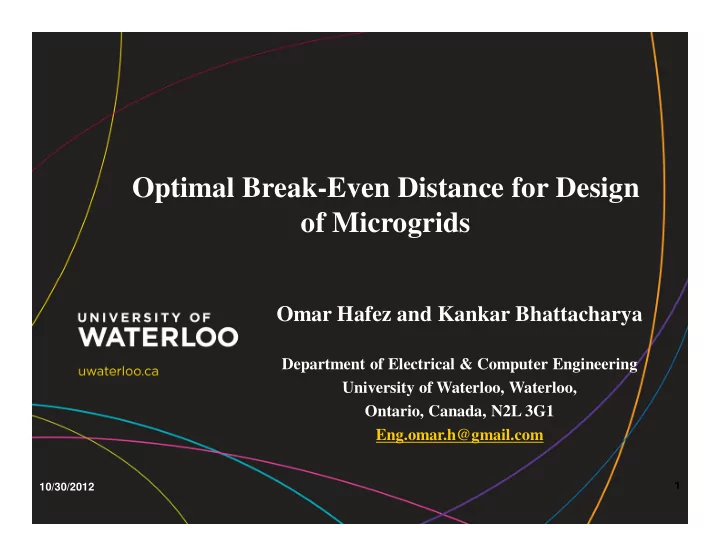

Optimal Break-Even Distance for Design of Microgrids Omar Hafez and Kankar Bhattacharya Department of Electrical & Computer Engineering University of Waterloo, Waterloo, Ontario, Canada, N2L 3G1 Eng.omar.h@gmail.com 1 10/30/2012
Outline o Introduction o Research Motivation o Objectives o Case study o Results o Conclusions 2 10/30/2012
Introduction Microgrids with renewable energy resources are becoming attractive options to meet electricity demand in remote locations, because of: Long distance between the nearest grid and rural • system High cost of transmission line expansion • High oil prices • Desire to reduce CO 2 emissions • Improve power quality • 3 10/30/2012
The Microgrid Microgrids are interconnection of DGs • With dispatchable generators (gas turbines, fuel cells) • Non-dispatchable generators (wind and solar PV) • Integrated with electrical and thermal energy storage • To meet customers’ local needs • Operate as a single system and small-scale • Provide both power and heat • 4 10/30/2012
Motivation • Cost of energy from conventional sources is typically lower than that from renewable energy sources • However a supply-mix of renewables and diesel can reduce overall cost of energy in a microgrid • There is a need to examine energy supply options in microgrids and determine the optimal supply mix – So that maximum benefits can be obtained from the design – To determine the optimal break-even distance for a micro- grid for isolated versus grid-connected mode of operation 5 10/30/2012
Objectives • Optimal design of microgrids considering various renewable energy technology options – With realistic inputs on their physical, operating and economic characteristics • Determine the break-even distance for connection of the microgrid with the main grid – Compare that with the cost of an isolated microgrid 6 10/30/2012
Microgrid Using HOMER Hybrid Optimization Model for Electric Renewable 7 10/30/2012
Test Case: Microgrid Components - Wind turbines - Solar PV array - Battery bank - Micro-Hydro turbines - Diesel generator - Dump load - Boiler - AC/DC converter 8 10/30/2012
Renewable Energy Resources • Solar radiation profile • Wind speed profile 9 10/30/2012
Case Studies: Microgrid Configurations • Case-1: Diesel Dependent Microgrid • Case-2: Renewable Based Microgrid – Wind, solar PV, battery, micro-hydro, converter • Case-3: Diesel-Renewable Mixed Microgrid – Diesel, wind, solar PV, battery, micro-hydro, converter • Case-4: Solar only Microgrid – Solar PV, battery, converter • Case-5: Wind only Microgrid – Wind, battery, converter 10 10/30/2012
Optimal Plan Configurations • Case-1: Diesel Dependent • Case-2: Renewable Based Microgrid Microgrid 11 10/30/2012
Optimal Plan Configurations…contd. • Case-3: Diesel-Renewable • Case-4: Solar only Mixed Microgrid Microgrid 12 10/30/2012
Optimal Plan Configurations…contd. • Case-5: Wind only Microgrid 13 10/30/2012
Comparing cost components & break- even distance Items Case-1 Case-2 Case-3 Case-4 Case-5 Net Present Cost, M$ 21.751 14.924 10.496 30.693 18.682 Levelized cost of energy, 0.932 0.639 0.449 1.405 0.8 $/kWh Operating Cost, M$/year 1.631 0.399 0.614 0.475 0.589 Break-even distance, km 918 579 359 1,363 766 14 10/30/2012
Comparing Production Production, MWh/yr Component Case-1 Case-2 Case-3 Case-4 Case-5 1,825 1,107.04 Diesel Generator 0 0 0 (100%) (46%) 633.5 3,800.8 Solar PV 0 0 0 (9%) (100%) 5,962.4 1,192.48 11,924.8 Wind 0 0 (89%) (49%) (100%) 115 115 Micro-Hydro 0 0 0 (2%) (5%) Boiler 182.5 0 0 14.1 0 Renewable Energy 100% 53.8% 99.6% 100% Contribution 0% Total 2,007.5 6,710.84 2,414.51 3,814.9 11,924.8 15 10/30/2012
Comparing consumption Consumption, MWh/yr Electrical Load 1,825 1,824.87 1,825 1,707.4 1,824.97 Energy Served Thermal Load 182.5 182.5 182.5 182.5 182.5 Energy Served Excess Energy to 0 4,703.34 407.01 1,925 9,917.3 dump load Unmet Energy 0 0.128 0 117.6 0.03 16 10/30/2012
Emission Comparison Emissions, ton/yr Case-4 Pollutant Case-1 Case-2 Case-3 Case-5 Carbon dioxide 4.47 3.43 6004.76 3.67 1078.4 Carbon monoxide 0 0 14.82 0 2.649 Unburned hydrocarbons 1.64 0 0.293 0 0 Particulate matter 0 0 1.12 0 0.2 Sulfur dioxide 12.06 0.008 2.17 0.009 0.007 Nitrogen oxides 0 0 132.23 0 23.64 17 10/30/2012
Effect of Distance from Grid: Optimal Break-even Distance • Case-1: Diesel Dependent • Case-2: Renewable Based Microgrid Microgrid 18 10/30/2012
Effect of Distance from Grid… contd. • Case-3: Diesel-Renewable • Case-4: Solar only Microgrid Mixed Microgrid 19 10/30/2012
Effect of Distance from Grid… contd. • Case-5: Wind only Microgrid 20 10/30/2012
Concluding Remarks • The diesel-renewable mixed microgrid (Case-3) has the lowest NPC which results in the shortest break- even distance of 359 kms • The break-even grid extension distance plays a significant role in microgrid design • The microgrid located beyond its break-even distance local generation is the economical and optimal option • HOMER is found to be an useful tool for microgrid planning and design 21 10/30/2012
22 10/30/2012
Recommend
More recommend